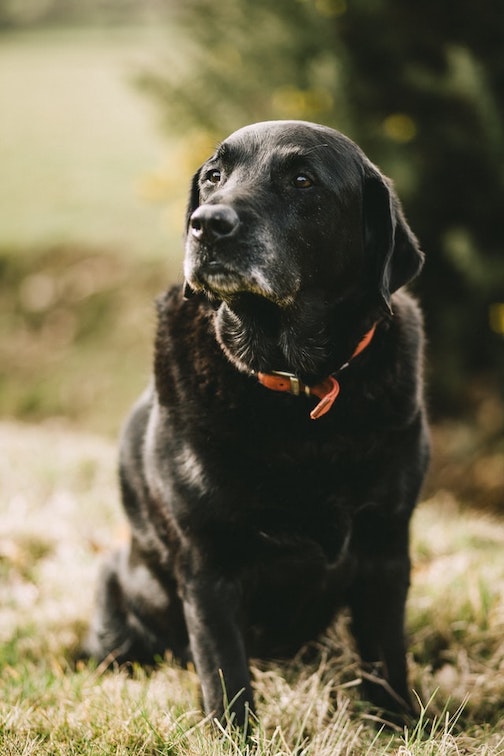Warning Signs: Health Issues in Senior Pets
Posted: 11/06/2023 | BY: Erin Cain | Categories: Uncategorized
Pets age just like humans do, and it can be hard to notice when they start developing health issues. This is why it’s essential to learn the warning signs of potential problems in older and senior pets, so you know if something needs medical attention. As pets live longer than they ever have before, their veterinary care and dietary habits are constantly evolving. This development has led to many new age-related conditions for both pet parents and vets alike. Thankfully, extensive research on the medical concerns associated with aging can help pet parents understand their pet’s unique needs when your pet reaches his senior years. Let’s examine some of the top senior pet health warning signs to look for in your older pet.

When does a pet become “old”?
If you have a cat or small dog, they are considered “senior” at seven years of age. Large breed dogs tend to live shorter lives than smaller breeds and can often be regarded as geriatric when they’re six years old. It’s important to remember that age isn’t a disease; it’s simply the normal aging process that elderly dogs and senior cats experience. With proper care and veterinary evaluations, your senior pet can age gracefully and comfortably.

Health warning signs in senior pets
As a pet parent, you may be struggling to decipher whether the changes in your senior dog or cat are part of normal aging or indications that he has serious health problems. Here are the top health warning signs is to look for:
Reduced mobility and exercise
If you notice your senior pet slowing down — literally — and not showing the same enthusiasm for walking, playing, or even jumping up into the car or on the couch, it may be a sign of arthritis. For elderly dogs and cats, arthritis has a direct impact on their physical and mental health. Pets with arthritis may show uncharacteristic irritable behaviors when petted or touched in painful areas because of this joint condition.
When your dog is stiff and limping, it may be an indication that they have arthritis. However, those symptoms can also signal severe diseases like hip dysplasia or osteoarthritis, which many owners overlook in their senior dogs because they write off their pet’s lethargy and stiff motions as just part of the aging process. But what if these symptoms are signs of severe chronic pain conditions affecting your pet’s joints? Dogs evolved over time to hide pain and injury, so watching and recording any changes you see in your dog or cat’s energy levels or mobility is critical to diagnosis the medical issue.
Your veterinarian can guide you in finding the best therapies and supplements for your senior pet’s arthritis or dysplasia. Various physical treatments, such as water therapy and laser therapy, can alleviate some of the pain senior pets experience. Supplements such as fish oil, glucosamine, chondroitin, and MSM are amongst the most successful methods of managing pet arthritis, so your elderly dog or cat can enjoy moving around pain-free.
Bad breath
It’s hard to miss a dog or cat with bad breath, but don’t be fooled by their smelly funk. Powerful odors can indicate periodontal disease and other age-related ailments, like tooth loss or gum bleeding, that could affect your pet if left untreated too long.
Watch out for pain while chewing or loss of appetite due to dental difficulties, tooth decay with bleeding gums, and difficulty chewing on only one side. If you notice any change at all when it comes to your pet’s oral health, make an appointment with your veterinarian as soon as possible to review your pet’s treatment options.
Professional teeth cleaning may not be possible for older pets, as they tend to negatively react to anesthesia. That doesn’t mean there’s no hope for your pet’s teeth. A good old-fashioned toothbrush and vet-approved pet toothpaste can help prevent bad breath. Even wiping a pet’s teeth with a washcloth is better than nothing. The trick is finding what your pet likes!
If your pet hates the toothbrush, try using a crunchy treat or cookie and placing the toothpaste on it to tempt your pet to chew it, thereby initiating a brushing action throughout the mouth.

Changes in appetite
Any change in your pet’s appetite, especially a sudden and abrupt change, could be a sign of a serious disease. Your veterinarian can help you get to the bottom of what is causing an increase or decrease in appetite.
It is easy to think that your pet’s increase in appetite could be a sign of good health, but changes in their eating habits can also stem from underlying illnesses. For example, cats with an overactive thyroid (hyperthyroidism) or underactive thyroid (hypothyroidism) will experience increased hunger and weight loss or gain. In older dogs, endocrine diseases such as Cushing’s syndrome cause the canine body to overproduce steroids at different rates, affecting appetite levels. Luckily, these health conditions have treatments available through medication typically covered by pet insurance.
A pet’s refusal of food can be a vital clinical sign. It could indicate the presence of a variety of illnesses, some of which are very serious and require immediate medical attention. If your senior pet has stopped eating, take her to the veterinarian or nearest emergency clinic to determine the cause of her condition.
Cognitive dysfunction and mental decline
Like people, pets experience memory loss and cognitive dysfunction as they age. One of the most common signs of mental decline in an older dog is the presence of “Old Dog Disease,” or vestibular disease. This cognitive disturbance affects dogs more than any other species and appears to be idiopathic in nature, meaning veterinarians don’t yet know what causes it. Should your dog show symptoms such as a tilted head or falling over while walking around circles for no reason, she could have this disorder that mimics conditions like strokes.
As for cats, feline cognitive dysfunction (FCD) affects roughly 55% of senior cats aged 11 to 15 years old. Felines between ages 16 – 20 have an 80% chance of developing FCD. Senior cats with feline cognitive dysfunction struggle to remember and learn new things. They may become more disoriented or less active as a result of their condition. Most importantly, memory loss causes significant disruptions in their lives, such as increased anxiety that may lead them to react aggressively and out of character towards their pet owners and other pets in the home.
For senior pets experiencing cognitive decline, there is hope. Veterinarians can refer pets to specialty therapists who work with pet parents to create a calm, consistent environment for the older dog or cat and investigate medications, such as anti-anxiety therapies, that may make life easier for the pet.

Behavioral changes
Behavior changes in your pet can be amongst the first indicators of aging. These behaviors might be due to discomfort or pain, but they may also worsen with age and have an underlying cause, such as cognitive dysfunction. Here are common behavioral changes that occur in aging cats and dogs:
- accidents in the home
- disoriented or confused behavior
- nervousness or anxiety
- changes in sleep patterns
- personality changes
- lethargy
- lack of interest in play
- increased vocalization
- unusually aggressive behavior
- irritability
- easily startled by loud noises
- lack of response to voice commands
- increased wandering
- excessive panting
- frequent pacing
Contact your veterinarian if your senior pet is exhibiting any of the above symptoms. The earlier diseases and cognitive decline can be diagnosed, the better the odds of managing it, so your pet enjoys her last years with you.
Urinary incontinence
Urinary incontinence is frustrating for both pet parents and their elderly pets. While the symptoms are common in aging pets who have lost control of their bladders or bowels, this problem may signify a much more severe illness: kidney disease. Your pet might also show significantly increased thirst, decreased appetite, and lethargy. Diagnosing kidney disease early is vital in preventing the development of renal failure, which can be highly damaging to your pet’s health as well as life-threatening if left untreated.
Your dog or cat is sensitive to their environment and will not want to eliminate in the wrong spot, no matter how well trained they are. Accidents at home lead pets to feel stressed out, so remember to never reprimand them for a situation they cannot control.
Weight gain or loss
Unintentional weight gain or loss in an older pet is a clear warning sign that something else is going on inside your furkid. While the physical signs of aging are inevitable, weight loss is a significant symptom for many serious diseases that affect older dogs. If your pet exhibits increased thirst and dehydration, increased appetite, or loses more than two pounds per month, then she could be suffering from diabetes. Because diabetic pets cannot properly absorb sugar, they may suffer from other consequences such as suppressed appetites and malnutrition. Other diseases associated with unexpected weight loss include congestive heart failure, Cushing’s disease, urinary tract infection, or bladder stones.
Many pets gain weight as a part of the normal aging process, but it’s also an indication that your pet may have hypothyroidism. Check their figure for signs of excess pounds that put too much strain on them, causing bone and joint problems like osteoarthritis or hip dysplasia. These conditions weaken pets’ cardiovascular health while making exercise more difficult to do. Obesity in pets impacts the whole body, leading to higher chances of developing other serious diseases.

Bumps and lumps
Pet and groom your older pet regularly so you can notice any lumps or bumps that develop on the pet’s body. Sometimes those lumps are simply fatty deposits, but they may also be the first sign of a tumor. This warning is essential for older dogs, 50% of whom over age 11 will develop some form of cancer. Many cancers can be successfully managed if caught early, allowing your senior pet to spend her final years in peace.
You must keep an eye out for lumps and tumors in order not only to catch potential cancer early but also to avoid any painful surgeries, such as amputation when treatment isn’t possible anymore based upon the cancer’s location.
Cloudy pupils
Cloudy pupils are often one sign pointing towards cataracts, which can lead to serious vision loss and glaucoma if left untreated. Senior pets whose eyes are starting to cloud over should receive veterinary attention as soon as possible. It is challenging to reverse the development of cataracts, and when the eyes cloud over, the cataracts are already moderately advanced. Check your senior pet’s eyes regularly to catch cataracts before they are fully developed.
More medical issues mean more vet visits. A pet insurance plan can make a difference.
Older dogs and cats lead to more veterinary visits, medical treatments, and costly vet bills. While these events are realities for pet parents with senior furkids, a pet insurance policy will cover most of your elderly pet’s medications, treatments, and veterinary clinic appointments. You don’t have to wait another minute longer! Pet Insurance Review has all the best insurance deals available for you and your budget. Get a free pet health insurance quote today, and purchase some extra security for your golden oldies.
References:
1. AVMA. (2021). Senior pets. Retrieved from https://www.avma.org/resources-tools/pet-owners/petcare/senior-pets
2. Bobbitt, H. (2018). Is Your Dog In Pain And Trying To Hide It? Retrieved from https://post.bark.co/health/dog-in-pain-signs/
3. Niemic, B. (2012). Treating and Preventing Dental Disease in Geriatric Pets. Retrieved from https://www.veterinarypracticenews.com/treating-and-preventing-dental-disease-in-geriatric-pets/
4. Morris Animal Foundation. (2020). Understanding Hyperadrenocorticism (Cushing’s Syndrome) in Dogs. Retrieved from https://www.morrisanimalfoundation.org/article/understanding-hyperadrenocorticism-cushings-syndrome-dogs
5. Cox, S. (2021). Idiopathic or “Old Dog” Vestibular Disease. Retrieved from https://thebark.com/content/idiopathic-or-old-dog-vestibular-disease
6. ASPCA. (n.d.). Older Cats with Behavior Problems. Retrieved from https://www.aspca.org/pet-care/cat-care/common-cat-behavior-issues/older-cats-behavior-problems
7. Ward, E. Beyond the Belly: The health consequences of pet obesity. Retrieved from https://www.veterinarypracticenews.com/beyond-the-belly-the-health-consequences-of-pet-obesity/
8. Lombard Veterinary Hospital. (2021). Dog Cancer – Symptoms, Diagnosis & Treatment. Retrieved from https://www.lombardvet.com/services/dogs/dog-cancer
Disclaimer
The information contained on this blog is intended for informational and educational purposes only and should not be construed as medical advice. It is not a substitute for professional veterinary care. Always consult with your veterinarian before making any changes to your pet's health care or treatment plan.
The authors of this blog are not veterinarians and do not claim to be experts in pet health. The information provided here is based on our own experiences and research, as well as information from reputable sources. However, we cannot guarantee the accuracy or completeness of this information.
We encourage you to do your own research and consult with your veterinarian before making any decisions about your pet's health.
Previous post
10 Superfoods for Dogs: What to Feed Your PupCompare top pet insurance providers plans.
Enter your dog’s age in years and months to calculate their age equivalent to human years.
Calculate your dog’s ageEnter your cat’s age in years and months to calculate their age equivalent to human years.
Calculate your cat’s age